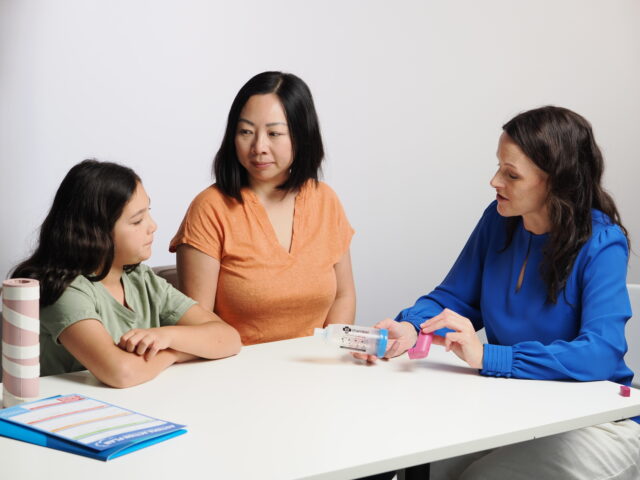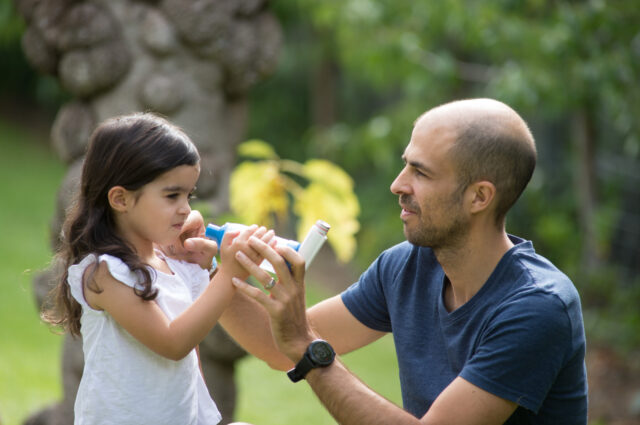Australian Asthma Handbook
The National Guidelines for Health Professionals
Cite
Table
| Mild–moderately severe | Severe | Life-threatening | |
| Description | All of: Can walk, speak whole sentences in one breath (younger children can speak in phrases) SpO2 (room air) >94% | Any of: Unable to complete sentences in one breath due to breathlessness Use of accessory muscles of neck or intercostal muscles/tracheal tug/subcostal recession during inspiration Obvious respiratory distress SpO2 (room air) ≤94% | Any of: Reduced consciousness/collapse, exhaustion Cyanosis Poor respiratory effort SpO2 (room air) <90% Poor respiratory effort, soft/absent breath sounds
|
Immediate treatment | Give salbutamol 4–12 actuations (100 microg per actuation) via pMDI and spacer (tidal breathing) Repeat salbutamol 4–12 actuations every 20–30 minutes for the first hour, if needed (sooner if needed) | Arrange transfer to acute care Give salbutamol 12 actuations (100 microg per actuation) via pMDI and spacer (tidal breathing), with mask if needed If patient cannot breathe through spacer, give 5 mg nebule via nebuliser Start oxygen supplementation if SpO2 <92%. Titrate to target SpO2 92–96% Repeat salbutamol 12 actuations at least every 20 minutes for first hour (3 doses) | Arrange transfer to acute care Give salbutamol 2 x 5 mg nebules via continuous nebulisation driven by oxygen Maintain SpO2 to target 92–96% |
Additional information
pMDI: pressurised metered-dose inhaler; SpO2: oxygen saturation measured by pulse oximetry
Table
| Mild–moderate (all of): | Severe (any of): | Life-threatening (any of): | |
| Consciousness | Alert | N/A | Drowsy or unconscious |
| Speech | Can finish a sentence in one breath | Can only speak a few words in one breath | Cannot speak |
| Posture | Can walk, sit up straight, lie flat | Unable to lie flat due to dyspnoea Sitting hunched forward | Collapsed or exhausted |
| Breathing | Respiratory distress is not severe | Paradoxical chest wall movement or Use of accessory muscles of neck or intercostal muscles during inspiration or Subcostal recession | Severe respiratory distress or Poor respiratory effort |
| Skin colour | Normal | N/A | Cyanosis |
| Respiratory rate | <25 breaths/min | ≥25 breaths/min | Bradypnoea (indicates respiratory exhaustion) |
| Heart rate | <110 beats/min | ≥110 beats/min | Cardiac arrhythmia or Bradycardia (may occur just before respiratory arrest) |
| Chest auscultation | Wheeze or Normal lung sounds | N/A | Silent chest or Reduced air entry |
| Oxygen saturation | >94% | 90–94% | <90% or Clinical cyanosis |
Additional information
N/A: Not applicable – may be the same as moderate and does not determine severity category
Recommendation type: Consensus recommendation
Shi C, Goodall M, Dumville J, et al. The accuracy of pulse oximetry in measuring oxygen saturation by levels of skin pigmentation: a systematic review and meta-analysis. BMC Med 2022; 20: 267.
Perform the assessment while preparing to administer salbutamol (and oxygen, if needed).
Pulse oximetry may overestimate oxygen saturation in people with higher levels of skin pigmentation.[Shi 2022]
Transfer to an acute care facility should be arranged if respiratory distress is severe enough to prevent the child speaking in whole sentences, or oxygen saturation ≤94%.
Recommendation type: Consensus recommendation
Mild–moderately severe exacerbation: 4–12 actuations
Severe exacerbation: 12 actuations
Repeat dose every 20 minutes for the first hour, if breathing difficulty not resolved.
If use of nebuliser unavoidable, use 5 mg nebule for severe exacerbation, 2 x 5 mg nebules for life-threatening exacerbation
Recommendation type: Consensus recommendation
Repeated administration of inhaled SABA every 20 minutes for the first hour is effective for rapidly achieving bronchodilation in patients with mild or moderate asthma exacerbations.[GINA 2025]
Salbutamol delivered via a pMDI with spacer is at least as effective as salbutamol delivered via nebuliser in school-aged children with acute asthma who do not require mechanical ventilation.[Cates 2005, Pollock 2017, Ferguson 2006]
The use of nebulisers may increase the risk of viral transmission.[Hui 2009, Biney 2024, Goldstein 2021] Healthcare workers should follow infection control procedures including use of personal protective equipment such as face masks.
Oral salbutamol or intravenous salbutamol are not recommended.
Biney IN, Ari A, Barjaktarevic IZ, et al. Guidance on mitigating the risk of transmitting respiratory infections during nebulization by the COPD Foundation Nebulizer Consortium. Chest 2024; 165: 653-668.
Cates CJ, Crilly JA, Rowe BH. Holding chambers (spacers) versus nebulisers for beta-agonist treatment of acute asthma. Cochrane Database Syst Rev 2006; Issue 2: CD000052.
Ferguson C, Gidwani S. Best evidence topic reports. Delivery of bronchodilators in acute asthma in children. Emerg Med J 2006; 23: 471-27.
Global Initiative for Asthma (GINA). Global Strategy for Asthma Management and Prevention, 2025. Available from: www.ginasthma.org
Goldstein KM, Ghadimi K, Mystakelis H, et al. Risk of transmitting coronavirus disease 2019 during nebulizer treatment: a systematic review. J Aerosol Med Pulm Drug Deliv 2021; 34: 155-170.
Hui DS, Chow BK, Chu LC, et al. Exhaled air and aerosolized droplet dispersion during application of a jet nebulizer. Chest 2009; 135: 648-654.
Pollock M, Sinha IP, Hartling L et al. Inhaled short-acting bronchodilators for managing emergency childhood asthma: an overview of reviews. Allergy 2017; 72: 183-200.
National Asthma Council Australia’s video on how to use a metered dose inhaler (puffer) with a spacer for children
National Asthma Council Australia’s fact sheet on spacers for pressurised metered-dose inhalers
Tidal breathing method:
1. Connect spacer to pMDI and tell patient to seal lips firmly around spacer mouthpiece.
2. Release up to 1 actuation of salbutamol into the spacer.
3. Tell the child to breathe in and out for four breaths while keeping lips sealed around mouthpiece.
4. Release 1 more actuation of salbutamol into the spacer and repeat until all required actuations delivered.
If the child cannot seal their lips tightly around the spacer mouthpiece, use a tightly fitting mask connected to the spacer mouthpiece.
If the child cannot breathe through a spacer using either the mouthpiece or a mask, use a nebuliser with mask.
The tidal breathing technique should only be used while the patient is too breathless to use the standard single-breath technique. Once breathing improves, consider switching to single-breath technique.
Use a cardboard disposable spacer or a new spacer afterwards given to the patient. Prime new spacers (unless anti-static) before use by releasing at least 10 actuations of salbutamol into the spacer.
Use a simple mask (flow rate 5 L/min) or nasal prongs (flow rate 3 L/min).
Recommendation type: Consensus recommendation
There is very little evidence available to inform recommendations for oxygen saturation targets in children with asthma. Recommended targets differ between major Australian paediatric teaching hospitals.
Delivery methods include simple mask (flow rate 5 L/min ) or nasal prongs (flow rate 3 L/min).[GWACAHS 2023] A minimum flow rate of 5 L/min for oxygen masks is necessary to avoid rebreathing of carbon dioxide.
The normal range oxygen saturation levels measured by pulse oximetry in children is generally stated as 95–100%. However, one study reported a normal range of 97–100% in healthy children without asthma aged approximately 5–13 years.[Elder 2015]
Some guidelines recommend pulse oximetry alarms to be set at 92% low and 99% high when a child is receiving oxygen therapy.[SCHN 2024] Others recommend targets of 94–98% [RCHM 2020] or >95%. Saturations of 100% should be avoided in patients receiving supplemental O2 (acceptable in a child breathing room air).[SCHN 2024]
Some guidelines suggest that, in a child recovering after acute asthma, SpO2 in the low nineties due to ventilation/perfusion mismatch is acceptable if the child is clinically improving.[RCHM 2020, RCHM 2023]
There is no physiological basis for administering low flow oxygen therapy to a child with normal SpO2 and increased work of breathing.[SCHN 2024]
Elder JW, Baraff SB, Gaschler WN, et al. Pulse oxygen saturation values in a healthy school-aged population. Pediatr Emerg Care 2015; 31: 645-647.
Government of Western Australia Child and Adolescent Health Service. Community Health clinical nursing manual. Oxygen administration. [Reviewed 26 October 2023].
The Royal Children’s Hospital Melbourne. Nursing guidelines. Oxygen delivery [webpage] [Approved December 2020].
The Royal Children’s Hospital Melbourne. Acute asthma. [webpage] [last updated July 2023]
The Sydney Children's Hospitals Network. Oxygen therapy and delivery devices. Practice guideline. Guideline No: 2015-9085 v5. 15 November 2024.
Shi C, Goodall M, Dumville J, et al. The accuracy of pulse oximetry in measuring oxygen saturation by levels of skin pigmentation: a systematic review and meta-analysis. BMC Med 2022; 20: 267.
The Royal Children’s Hospital Melbourne’s guidance on oxygen delivery
The Sydney Children's Hospitals Network’s practice guideline on oxygen therapy and delivery devices
Mask and spacer can be applied over nasal prong oxygen to deliver inhaled bronchodilator [RCHM 2023]
Pulse oximetry may overestimate oxygen saturation in people with higher levels of skin pigmentation.[Shi 2022]
Perform a physical examination including auscultation, vital signs, and repeated pulse oximetry.
Complete a brief history, including:
Recommendation type: Consensus recommendation
The association of asthma and food allergy is a risk factor for fatal and near-fatal allergic reactions to food allergens.[Burks 2012]
Burks AW, Tang M, Sicherer S, et al. ICON: food allergy. J Allergy Clin Immunol 2012; 129: 906-920.
Recommendation type: Consensus recommendation
Children 6–11: prednisone/prednisolone 1 mg/kg (maximum 50 mg) orally each morning for 3 days
Systemic corticosteroid are not required if the exacerbation was assessed as mild at initial assessment.
Recommendation type: Consensus recommendation
In school-aged children with acute asthma managed in emergency departments, administration of systemic corticosteroids within 1 hour of presentation reduces the need for hospital admission.[Rowe 2001] After an acute asthma episode managed in the emergency department, treatment with systemic corticosteroids (intramuscular corticosteroids, oral prednisone/prednisolone, or oral dexamethasone) at discharge reduces the risk of relapse in children.[Castro-Rodriguez 2015, Kirkland 2018]
Doses
Prednisolone/prednisone: Most studies assessing systemic corticosteroids for children with acute asthma have used an initial dose of 1–2 mg/kg oral prednisolone (maximum 60 mg), then 1 mg/kg per day. Current evidence does not support the use of higher doses. [Normansell 2016]
In children, a 3-day course of prednisone/prednisolone is generally as effective as a 5-day course.[Chang 2008]
Oral dexamethasone: Most studies evaluating oral dexamethasone in children have used 0.6 mg/kg per dose on one or two consecutive days.[Paniagua 2017] Dexamethasone has a longer half-life than prednisone/prednisolone. Longer courses may cause more pronounced mineralocorticoid adverse effects. Oral dexamethasone treatment should not exceed 2 days. In children it may be associated with less vomiting than prednisone/prednisolone.[Paniagua 2017, Bravo-Soto 2017, Meyer 2014, Keeney 2014, Cronin 2016]
Safety
Short-term: short courses of oral corticosteroids to treat acute asthma are often well tolerated in children,[Rowe 2001, Smith 2003, Rowe 2007] but may be associated with mood changes, nocturia, and difficulty sleeping.
Long-term: short courses of oral corticosteroids to manage asthma exacerbations are associated with increased lifetime risk of osteoporosis, pneumonia, cardiovascular or cerebrovascular diseases, cataract, sleep apnoea, renal impairment, depression/anxiety, type 2 diabetes, and weight gain. [Price 2018]
Bravo-Soto GA, Harismendy C, Rojas P et al. Is dexamethasone as effective as other corticosteroids for acute asthma exacerbation in children? Medwave 2017; 17: e6931.
Castro-Rodriguez, J. A., Rodrigo, G. J., Rodriguez-Martinez, C. E. Principal findings of systematic reviews for chronic treatment in childhood asthma. J Asthma 2015; 52: 1038-45.
Chang, A B, Clark, R, Sloots, T P, et al. A 5- versus 3-day course of oral corticosteroids for children with asthma exacerbations who are not hospitalised: a randomised controlled trial. Med J Aust 2008; 189: 306-310.
Cronin JJ, McCoy S, Kennedy U et al. A randomized trial of single-dose oral dexamethasone versus multidose prednisolone for acute exacerbations of asthma in children who attend the emergency department. Ann Emerg Med 2016; 67: 593-601.e3.
Keeney GE, Gray MP, Morrison AK et al. Dexamethasone for acute asthma exacerbations in children: a meta-analysis. Pediatrics 2014; 133: 493-9.
Kirkland SW, Vandermeer B, Campbell S et al. Evaluating the effectiveness of systemic corticosteroids to mitigate relapse in children assessed and treated for acute asthma: A network meta-analysis. J Asthma 2018: 1-12.
Meyer JS, Riese J, Biondi E. Is dexamethasone an effective alternative to oral prednisone in the treatment of pediatric asthma exacerbations? Hosp Pediatr 2014; 4: 172-80.
Normansell R, Kew KM, Mansour G. Different oral corticosteroid regimens for acute asthma. Cochrane Database Syst Rev 2016; Issue 5: CD011801.
Paniagua N, Lopez R, Muñoz N, et al. Randomized trial of dexamethasone versus prednisone for children with acute asthma exacerbations. J Pediatr 2017; 191: 190-196.e1.
Price DB, Trudo F, Voorham J, et al. Adverse outcomes from initiation of systemic corticosteroids for asthma: long-term observational study. J Asthma Allergy 2018; 11: 193-204.
Rowe BH, Spooner C, Ducharme F, et al. Early emergency department treatment of acute asthma with systemic corticosteroids. Cochrane Database Syst Rev 2001; Issue 1: CD002178.
Rowe BH, Spooner C, Ducharme F, et al. Corticosteroids for preventing relapse following acute exacerbations of asthma. Cochrane Database Syst Rev 2007; Issue 3: CD000195.
Smith M, Iqbal S, Elliot TM et al. Corticosteroids for hospitalised children with acute asthma. Cochrane Database Syst Rev. 2003; Issue 2: CD002886.
Prescribers should avoid supplying parents with more prednisone/prednisolone than needed for the course. Prescribers may write PBS scripts for less than the maximum quantity and number of repeats permitted if a lesser quantity is sufficient for the patient’s requirements.
The supervising person (e.g. primary care nurse or parent/carer) should call an ambulance if symptoms recur.
Recommendation type: Consensus recommendation
Provide written instructions to use an adequate dose of ICS, to use reliever as needed, to continue oral prednisone/prednisolone, and to call ambulance or go to the emergency department if symptoms recur.
Consensus recommendation
Checkup at day 3–5 aims to check adherence to oral corticosteroids (if prescribed) and ICS.
The purposes of comprehensive asthma review after resolution of the exacerbation are:
Information on assessing and reviewing asthma in children 6–11 years
Give adrenaline first, before bronchodilator.
Doses using ampoule (1:1,000) and syringe:
4–6 years (approximately 20 kg): 0.2 mL IM into lateral mid-thigh
7–10 years (approximately 30 kg): 0.3 mL IM into lateral mid-thigh
11–12 years (approximately 40 kg): 0.4 mL IM into lateral mid-thigh
Recommendation type: Adapted from ASCIA 2024
Anaphylaxis should be suspected when asthma-like respiratory symptoms are accompanied by either of the following features: [ASCIA 2024]
ACAQH. Immediate injection of intramuscular adrenaline. Quality statement 2. Australian Commission on Safety and Quality in Health Care. https://www.safetyandquality.gov.au/standards/clinical-care-standards/acute-anaphylaxis-clinical-care-standard/quality-statements/immediate-injection-intramuscular-adrenaline
ASCIA. Acute management of anaphylaxis. 2024, Australasian Society of Clinical Immunology and Allergy.
Australian Prescriber’s Anaphylaxis: emergency management for health professionals wallchart
ASCIA Guidelines: Acute management of anaphylaxis
When anaphylaxis is suspected adrenaline should be given immediately,[ACAQH 2025] and before considering salbutamol.[ASCIA 2024]
Use doses as for anaphylaxis.
Recommendation type: Consensus recommendation
Adrenaline is not used routinely in the management of severe acute asthma.
Its use should be reserved for situations where inhaled salbutamol cannot be given in a patient with respiratory arrest or pre-arrest status, or when anaphylaxis is suspected.
Doses are based on ASCIA recommendations for managing anaphylaxis.[ASCIA 2024]
Evidence for outcomes with adrenaline in the treatment of acute asthma is mainly from clinical trials conducted before 2000.[Baggott 2022] There is insufficient evidence to determine whether inhaled salbutamol is more effective than adrenaline as first-line treatment in the management of severe acute asthma, due to high risk of bias in published clinical trials and significant heterogeneity, including differences in study design.[Baggott 2022] Available evidence suggests adrenaline may be more effective in adults than in children.[Baggott 2022]
Low-quality evidence suggests that adrenaline is associated with higher rates of agitation, tremor and headache than inhaled salbutamol.[Baggott 2022]
There is also insufficient evidence to determine whether intramuscular adrenaline, given in addition to inhaled salbutamol, is more effective than inhaled salbutamol alone.[Baggott 2022]
Ambulance Victoria. Clinical practice guidelines. Version 3.12.17 (2025).
ASCIA. Acute management of anaphylaxis. 2024, Australasian Society of Clinical Immunology and Allergy.
Baggott C, Hardy JK, Sparks J, et al. Epinephrine (adrenaline) compared to selective beta-2-agonist in adults or children with acute asthma: a systematic review and meta-analysis. Thorax 2022; 77: 563-572.
International asthma guidelines recommend inhaled salbutamol as the primary bronchodilator in acute asthma, and do not recommend the use of adrenaline except for patients with concomitant acute asthma and anaphylaxis or angioedema.[Baggott 2022] However, intramuscular adrenaline in addition to inhaled SABA is included in ambulance guidelines for prehospital management of acute asthma in some jurisdictions,[Baggott 2022] including in some Australian states (e.g. for children with acute asthma and critical status).[Ambulance Victoria 2025]
The standard, recommended method (single-breath technique) is to take a single slow deep breath after each actuation into the spacer, then hold the breath for 5 seconds, then exhale away from the spacer.
The alternative method (tidal breathing) is used during acute exacerbations, when people usually cannot coordinate actuation and breathing. Up to 2 actuations are released into the spacer at the same time, and the patient takes multiple breaths, breathing in and out through the spacer mouthpiece.
The tidal breathing method is usually used in EDs to deliver SABA in acute asthma, but patients should revert to the preferred single-breath technique after discharge.

Principles of management
How to assess asthma control and severity in children. Risk factors for asthma exacerbations and what to includes at…

Principles of management
How to equip and coach children and their parents to manage childhood asthma, including exacerbations.

Medication management
How to step up or step down asthma treatment for a child aged 6–11 years, to maintain symptom control, prevent…